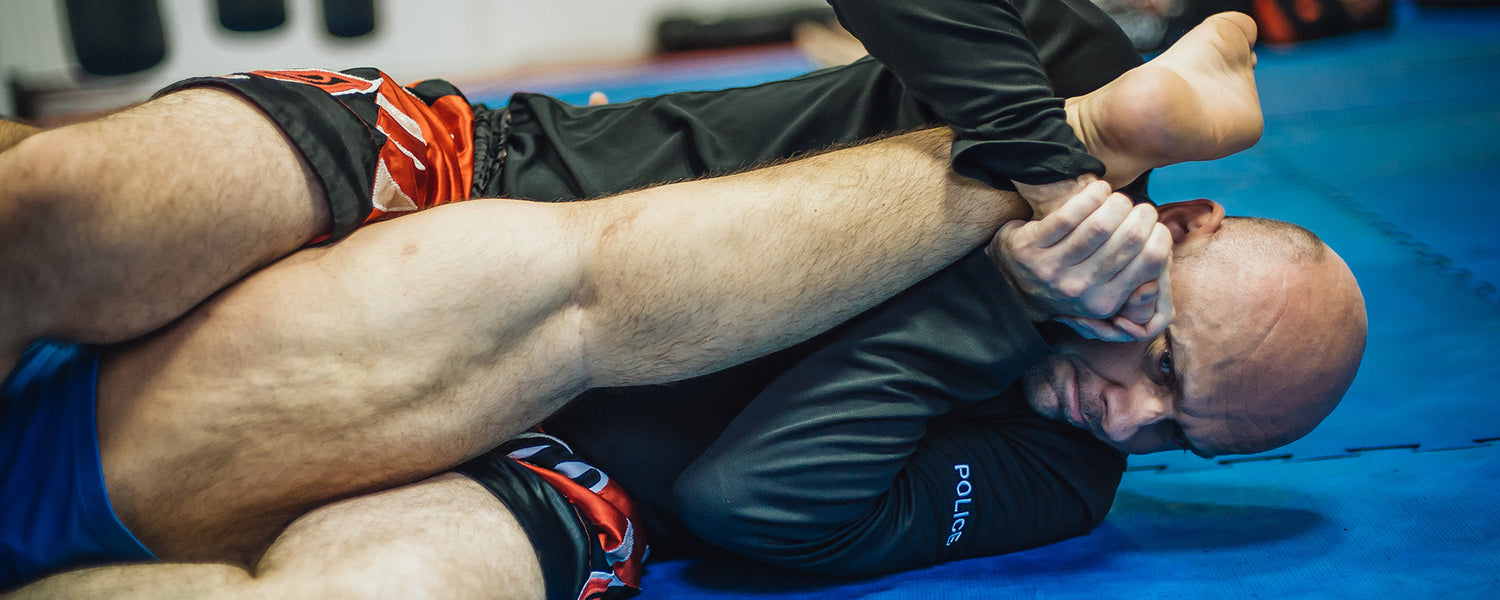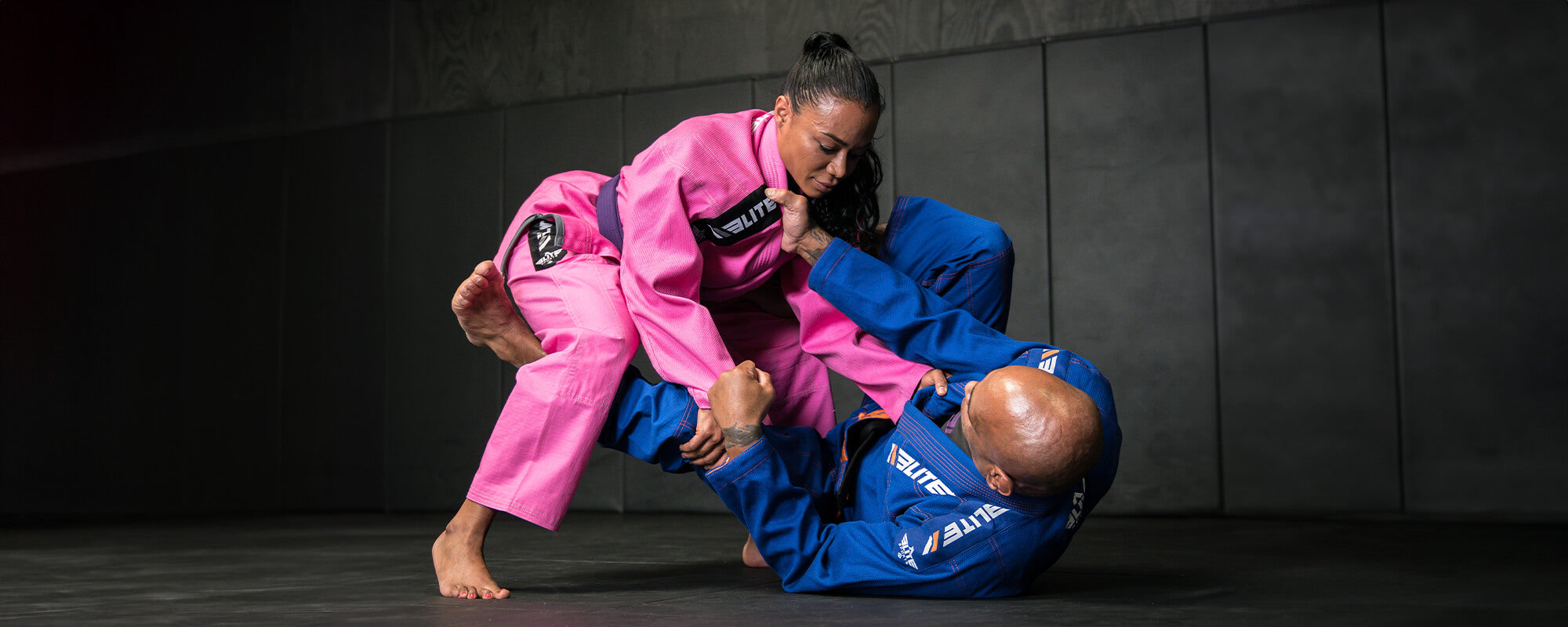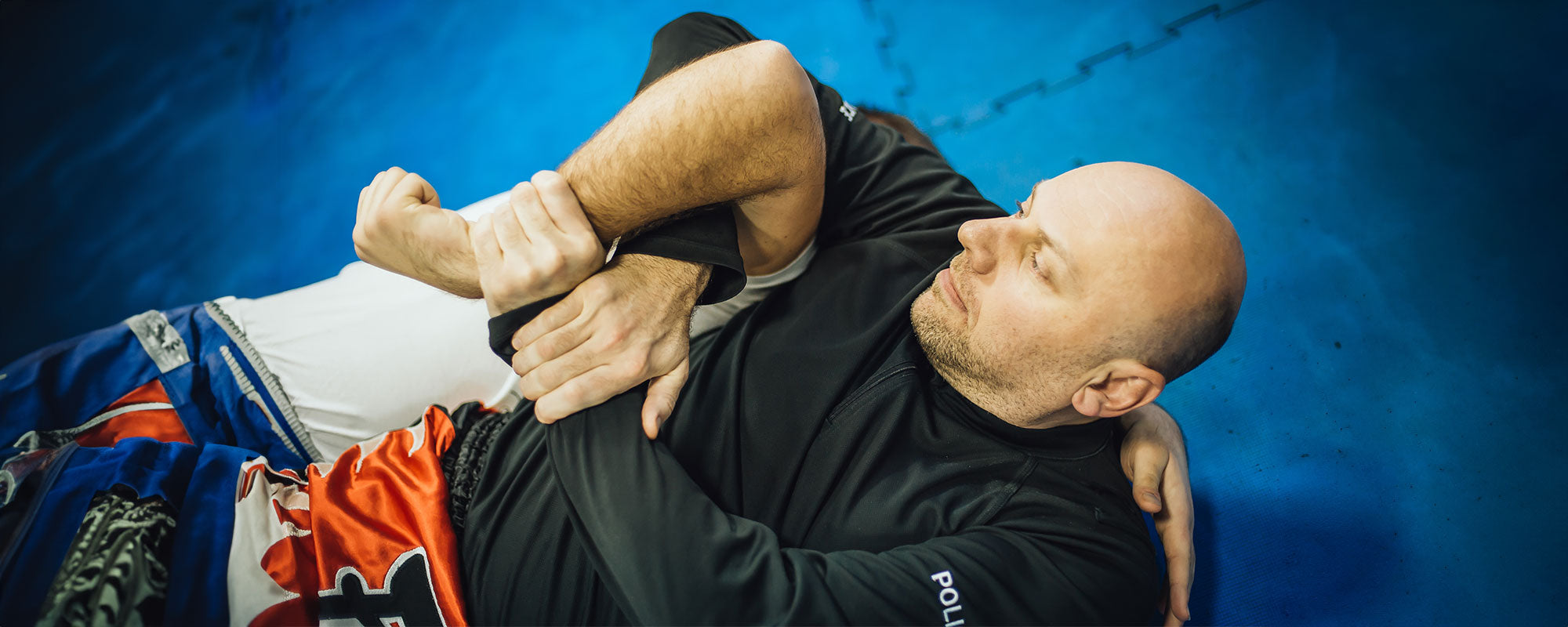Table of content
1. What is BJJ Kneebar?

Kneebar is the submission method used in Brazilian jiu-jitsu ( BJJ ) and mixed martial arts (MMA). It is a joint lock that entangles the knee joint, and the fighter applies a certain amount of force to submit the opponent.
The kneebar is the strangle applied to the lower body, and it is the reverse or similar submission to the armbar executed on the knee joint. The leverage is created after the proper positioning of the leg locks. Kneebar is a versatile move that tends to uplift the game, whether it is jiu-jitsu or you are applying it in MMA.
2. Mechanism of BJJ Kneebar
The kneebar is the leglock that targets the three joints of the legs: hip bone, knee, and ankle joint. However, as the name suggests, the particular function of this leglock submission is to aim at the knee joint.
These techniques are highly effective and also provide the highest percentage, as the submissions are applied to disrupt the opponent's balance and position. After taking control of the leg, it works on maintaining the proper angle. The knee is hyperextended by pulling the leg in the backward direction.
The leglock of the kneebar is the secret weapon of the top contenders in BJJ and MMA. In this article, we will delve into the step-by-step guide to the kneebar and explore its different variations.
Note that the submission method works when you apply the proper angle and the leverage to break the mechanics or misalign the structure to get the submission.
3. Execution of Kneebar for BJJ and MMA
Kneebar is the safest move that can be applied to the leg lock, it works on the mechanics of the proper placement of the legs that creates an ascertain angle from which force is exerted to submit the opponent.

The ideal step to maintain the correct body angle is to take control of one of the legs. The fighter holds the foot of the opponent and creates an angle of ninety degrees. The fighter has made the entanglement that restricts the movement of the knee from moving at any place. It creates massive pressure on the knee joint, making the opponent submit simultaneously.
3.1. Take the Position
In the first step, the fighter is required to take a certain position, which can be the bottom half guard , side control, or even the open guard position.
3.2. Target the Leg
The second part is to target one of the legs on which you want to apply the kneebar submission.
3.3. Hold the Knee
Target the knee and place the inner side of the leg over the knee joint so that there will be less or no space to move.
3.4. Take the Grip over the Foot
The next important step is to get a stronger grip on the foot and hold it with both of hands.
3.5. Slide Down to One Side
After the entanglement, slide down to the same side of the leg, stretch the leg, and keep the foot close to your face. Hold the foot with the four fingers with the upper hand. While the bottom hand uses the leverage and holds the heel on the upper part of the elbow.
3.6. Create the Hook
Hold the bicep to create the proper grip while the legs are joined with the foot hook, making the strangle more tricky and complex.
3.7. Finishing the Kneeabar
Maintain the grip of the hands and keep the leg hooks in place; lean back with the extending leg until the opponent goes for a tap.
4. Variations of the BJJ Kneebar
The bjj kneebar is a dynamic move that can be applied from various positions. It provides the highest percentage as it can be applied even from the standing position.
Let us learn about the kneebar variations along with the step-by-step execution.
4.1. Bottom Half Guard and Kneebar
It is a very interesting variation of the jiu-jitsu kneebar in which the fighter takes the ground position. He keeps his back on the mat and targets one of the opponent's hands. The main step in this variation is to do the flip by sliding the body to one side, where the arm is taken.
The next important move is to apply pressure to the opponent so that he faces the mat. At that time, the fighter holds the targeted leg or knee to execute the bjj kneebar submission.
It is the unpredictable move that creates the highest percentage of victory.
- The first step is to hold the fighter's sleeve or wrist; the other hand is used to control the knee on the same side.
- One leg is placed in between the opponent’s leg.
- The figure will take the opposite side leg and put it over the side of the opponent by sliding the body to one side.
- The next step is to extend the leg at a straight angle and place it close to the armpit.
- Now, move the fighter's direction to the other side so that the fighter comes to the mat with one leg entangled.
- Keep the hand at the back of the foot and stretch the foot so that the fellow fighter goes for a tap.
- Make sure to keep the leg joints straight so that there will be no way to escape.
4.2. X- Guard Kneebar
The X-guard kneebar is also a dynamic move that can strangle the opponent in the kneebar submission. In this move, the fighter uses the grip of the lapel to maintain the space after dragging the opponent down to the mat. This helps to create a way for setting the angle of the leg to submit.
- The first step is to keep one of the hands on the lapel or collar and drag the oppoent down to the mat.
- This creates the space so that the fighter can place the leg.
- Lay down on the mat and keep one of the legs on the ribs.
- Hold the collar with one hand and the leg with the other hand.
- Keep the opponent's leg over the shoulder.
- Move the outside leg over the opponent and turn towards the other side.
- Create the hook over the hips with the foot and place the hand over the shin.
- For the finish, keep both hands at the back of the heel and apply pressure until the opponent submits.
4.3. Kneebar from the Half-Guard
This is the bjj kneebar variation that can be applied in the BJJ Gi. The fighter takes control of the lapel and drags the opponent over himself. The leg is placed under the armpit, and the other hand targets the knee on the opposite side.
The hook is created under the leg, keeping the straight angle of the leg placed under the armpit. Turn the side with the leg shift to apply the armbar submission.
- Get the collar or lapel grip, then create the underhook over the leg with the hand.
- Insert the leg or the upper part of the shin under the armpit to limit the opponent.
- Move the leg over the opponent’s head and create the hook over the heel.
- Use one hand to drag the opponent's foot.
- Take a firm grip and shift the opposite side to target the kneebar.
- Hold the back of the foot and apply the pressure for the finish.
4.4. Victor Roll
Victor Roll is one of the popular bjj kneebar methods used in the martial art of Sambo. Later, with its evolution, it became part of jiu-jitsu and is also used in MMA tournaments.
The name signifies victor roll, which is a technique involving rolling fighters. It can be applied in the standing position to maximize the fighter's opportunities. It is the best takedown method that locks the fighter in the kneebar at once.
- In the first step, the fighters are in the standing position.
- The fighter controls one of the arms and holds the shoulder at the back.
- The one hand of the fighter is placed at the torso.
- Grip one leg on the same side as the bent knee, then place the foot at the back of the knee on the opposite leg.
- Bend down and hold the heel of the same side with the hand.
- Bend down to the ground and move along with the opponent.
- As you sit on the mat,, place one leg over the opponent's targeted leg and hold it straight in the bent arm.
- Slide to one side of the mat to finish the kneebar submission.
4.5. Kneebar from Side Control
The kneebar from the side control position is sneaky; start the kneebar after taking the proper position. It is one of the easiest kneebar variations applied from the side control or side mount position.
The fighter takes control of the torso and then locks one of the legs under the control. The final step is to slide the leg over the opponent to apply the kneebar.
- Approach from the side and hold the opposite shoulder of the opponent.
- Keep the other hand at the back of the neck.
- After lifting the back, slide the opponent to one side; at that time, drag the near leg under the opponent's leg.
- The next step is to move the leg over the opponent and sit on the lower body.
- Slide to the other side and stretch the leg of the opponent for the finish.
4.6. Kneebar from Open Guard
To execute the kneebar method, it is crucial to hyperextend the leg from the open guard position. The fighter must pay close attention to the angle of the leg positioning. This helps to create leverage, which can break the posture.
- As the fighter approaches from the open guard, he will target the opponent's knees.
- Keep the arms on the knees in the standing position.
- The next step is to take the sitting position just over the opponent.
- Keep one hand under the leg and secure the grip with the other.
- Isolate the leg and lift it upwards.
- Slide or bend in one direction towards the mat.
- The leg is tilted in one direction.
- Maintain the pressure over the leg and under the hand and face.
- Apply the pressure with the hand until the opponent taps out.
4. Last Words
The art of Brazilian jiu-jitsu has become a versatile sport, and it has adopted many moves from various sports. This has given the fighters of BJJ and MMA many advantages. In the modern world, the art of BJJ has evolved, and it has become more dynamic and profound with the changes adopted by the fighters.
Fighters do not use the same technique that they did in the past; instead, BJJ and MMA contenders work on variations of submission that can provide better transitions and sweeps. The combination of armbars and leg locks has evolved the sport and taken it to another level.



Leave a comment
This site is protected by hCaptcha and the hCaptcha Privacy Policy and Terms of Service apply.